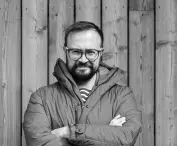Things began to take a different turn somewhere in the mid-2000s. Polish suburbs had already developed their own formal language combining nostalgia for the manor house in the Borderlands with the need for pistachio/pink/peach expressions native to American cities. Each bungalow was different in the multiplicity of roof kinks, window shapes and formats and, of course, in the paint job. The wealthier ladies of the house saw to it that, in addition to Provençal kitchens, the homes featured floors of wenge, lapacho and other exotic woods with names that twist the tongues of newcomers to home depot sales departments. Meanwhile, in some places, people began to appear, to their horror, who ostentatiously denied this freedom. And this is both unleavened and elitist. For example, owners of semi-detached houses, who, instead of shouting out their new capitalist freedom by painting each half differently, began to get along to standardize the facades. Anthracite and off-white appeared. Black window frames. Gray plinth plasters. Subdued combinations of mass-colored materials. All-white interiors, as from Swedish summer houses. Inevitably, these were menacing symptoms of a Calvinist Reformation smoldering somewhere under the skin. Just kidding, don't let the bishop get upset. Rather, it was simply that part of our new middle class had become overeager for excess and began to move toward relative uniformity, which, paradoxically, fleet cars could bring as an aesthetic reference. It was they - relatively modest, reliable and economical, that probably began to become figure-symbols for entire households. After all, who is going to trust a manager or small businessman focused on steady but slow growth if that person arrives at a meeting in a roaring Dodge Charger? And such a safe Opel, a solid Volvo or a domestic škodička does not hurt the neighbor's eyes, does not damage the budget, and nicely "washed" on a Sunday morning adorns the driveway with bauma paving stones, when we go to church as a family. And such a pater familias, standing in the middle of the driveway, can visually embrace the front of his latifundium, tasting with satisfaction as the breeze lazily licks the cobwebs on an even row of thuyas from Obi. And the anthracite strip of plinth plaster looks exactly as it did the day it was laid. However, I have to do justice to this color code, because I myself pay homage to it to some extent. Whether in a petit-bourgeois or hipster-designer version, this formal language ages the least, guaranteeing architects and their clients a much-coveted timelessness.
The more I mature, or maybe just get older, it hits me how much color means. It is the equivalent of language, an expression of aspirations and social opportunities, but also an individual expression of feelings. It can be a "moody master" (natural dyes), an "a propos" (beige, ecru) and a "feedback and deadlin" (RAL colors). It results from external influences, but also sometimes deeply rooted in tradition. It can be an agreed social norm, an important component of the aesthetic code of a particular group or class, but also a superficial and temporary fondness of readers of color magazines and followers of Pinterest. For colors, like concepts, become commercially traded objects when they make their way from some artistic niche straight into the mainstream, when interior design magazines publish triumphantly that "this year's color of choice is Pantone...". Color gives meanings and takes on meanings itself, as it combines with materials and forms. It is a mimicry, a camouflage, a slime and, above all, a signal. It can also soothe ghettoized middle-aged fathers who, little like the village fool in Woody Allen's "Love and Death," find peace of mind in stroking stretches of deep navy blue satin, juicy orange ripstop polyester or thick moleskine cotton in earthy ochre.
I've lived through several "formal regimes," including color. Today I live in a world of an infinite palette of possibilities, where colors and their combinations can be shaped in the real world, as if we were in a digital graphics program. Undoubtedly, the gray scale and then the reaction to it have influenced me greatly; so much so that today I am close to both the "protean" contrasts of anthracite and white, and the anarchic bursts of orange, red and yellow native to the global South. Today I know that color can be an expression of conjuring happiness and strong feelings, as in the painted stretches of walls in the buildings of Mexican genius, Luis Barragán. There, deep pinks or oranges literally explode, reflecting light and creating a warm "halo" that is put on objects and people's faces, and they get younger and healthier. And the same colors in fluo and reflective versions save thousands of lives on highways and sea defiles.
In addition to everything, color is a great antidote to all the brown grays of the Polish plague, marco-November inevitably stretching more and more into other months due to climate change. It is also an antidote to the native version of La Grande Noirceur, the period of the Great Blackness (when Canadian Quebec was de facto ruled by the Catholic Church). Vibrant color can combat the undercurrent of Polish brownness, which shudders at the sight of a rainbow for good reason. Because color, ladies and gentlemen, is also power. A power that anyone with a paintbrush and a bucket of paint in their hand has.















